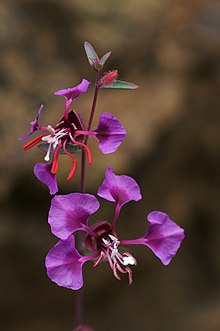User:Rleonen128/Clarkia unguiculata
| Rleonen128/Clarkia unguiculata | |
|---|---|

| |
| Scientific classification | |
| Kingdom: | Plantae |
| Clade: | Tracheophytes |
| Clade: | Angiosperms |
| Clade: | Eudicots |
| Clade: | Rosids |
| Order: | Myrtales |
| Family: | Onagraceae |
| Genus: | Clarkia |
| Species: | C. unguiculata
|
| Binomial name | |
| Clarkia unguiculata | |
| Synonyms[2] | |
| |
Distribution
[edit]Clarkia unguiculata is a species of wildflower known by the common name elegant clarkia or mountain garland.[3] This plant is endemic to California, where it is found in many woodland habitats.[4] It grows along the coastal ranges of Mendocino and San Diego. Clarkia unguiculata can also be found in the Sierran foothills. Specifically it is common on the forest floor of many oak woodlands, along with typical understory wildflowers that include Calochortus luteus, Cynoglossum grande and Delphinium variegatum.[5] It flowers in the summer and fall and thrives in somewhat neutral soil pH.
Morphology
[edit]C. unguiculata presents a spindly, hairless, waxy stem with a red hue. The species can grow up to 3 ft (0.9 m) tall with a small number of leaves populating the stem.[6] The showy flowers have hairy, fused sepals forming a cup beneath the corolla, and four petals each one to 2.5 cm (1.0 in) long.[7] The paddle-like petals are a shade of pink to reddish to purple and are slender and diamond-shaped or triangular in a raceme formation, in which each flower is connected to the main stalk by a pedicel, a short stem extension.[6] There are eight long stamens, the outer four of which have large red anthers. The stigma protrudes from the flower and can be quite large.
Ecology
[edit]Clarkia unguiculata is a simple species as it interacts mainly with its pollinators, these being a variety of bees, butterflies and some bats.[6] The main pollinator is the Hesperapis regularis, a native species of bees found in similar environments to C. unguiculata.[8] This plant has the ability to self-pollinate.[9] The ability to self-pollinate means the species is not heavily reliant on the presence of pollinators like bees or butterflies. Despite having a mutualistic relationship with other species, this flower can persevere by itself if certain conditions are met.
Commercial Cultivars
[edit]-
Albatross
-
Firebrand
-
Lilac
-
Tall Double Mix
References
[edit]- ^ "Clarkia unguiculata". NatureServe.
- ^ "Clarkia unguiculata". Plants of the World Online. Royal Botanic Gardens, Kew. Retrieved 16 November 2024.
- ^ "Natural Resources Conservation Service", Wikipedia, 2024-11-15, retrieved 2024-11-19
- ^ Calscape. "Elegant Clarkia". calscape.org. Retrieved 2024-11-19.
- ^ "Yellow Mariposa Lily (Calochortus luteus ) - photo/images/information - GlobalTwitcher.com". web.archive.org. 2011-10-04. Retrieved 2024-11-19.
{{cite web}}: no-break space character in|title=at position 71 (help) - ^ a b c "Lady Bird Johnson Wildflower Center - The University of Texas at Austin". www.wildflower.org. Retrieved 2024-11-19.
- ^ "Archived TJM 1993 treatment for CLARKIA unguiculata". ucjeps.berkeley.edu. Retrieved 2024-11-19.
- ^ Peach, Kristen; Mazer, Susan J. (2019-04). "Heteranthery in Clarkia : pollen performance of dimorphic anthers contradicts expectations". American Journal of Botany. 106 (4): 598–603. doi:10.1002/ajb2.1262. ISSN 0002-9122.
{{cite journal}}: Check date values in:|date=(help) - ^ Moeller, David A.; Geber, Monica A. (2005). "ECOLOGICAL CONTEXT OF THE EVOLUTION OF SELF-POLLINATION IN CLARKIA XANTIANA: POPULATION SIZE, PLANT COMMUNITIES, AND REPRODUCTIVE ASSURANCE". Evolution. 59 (4): 786. doi:10.1554/04-656. ISSN 0014-3820.
External links
[edit][edit] Media related to Clarkia unguiculata at Wikimedia Commons
| This is the sandbox page where you will draft your initial Wikipedia contribution.
If you're starting a new article, you can develop it here until it's ready to go live. If you're working on improvements to an existing article, copy only one section at a time of the article to this sandbox to work on, and be sure to use an edit summary linking to the article you copied from. Do not copy over the entire article. You can find additional instructions here. Remember to save your work regularly using the "Publish page" button. (It just means 'save'; it will still be in the sandbox.) You can add bold formatting to your additions to differentiate them from existing content. |






